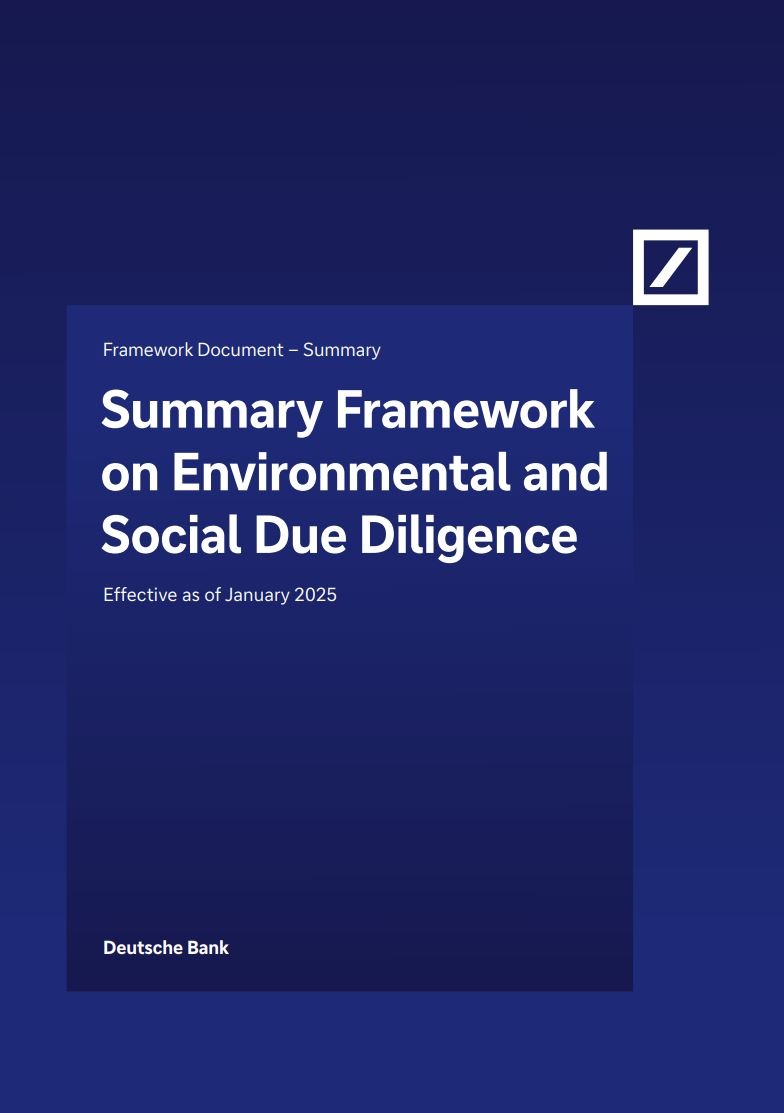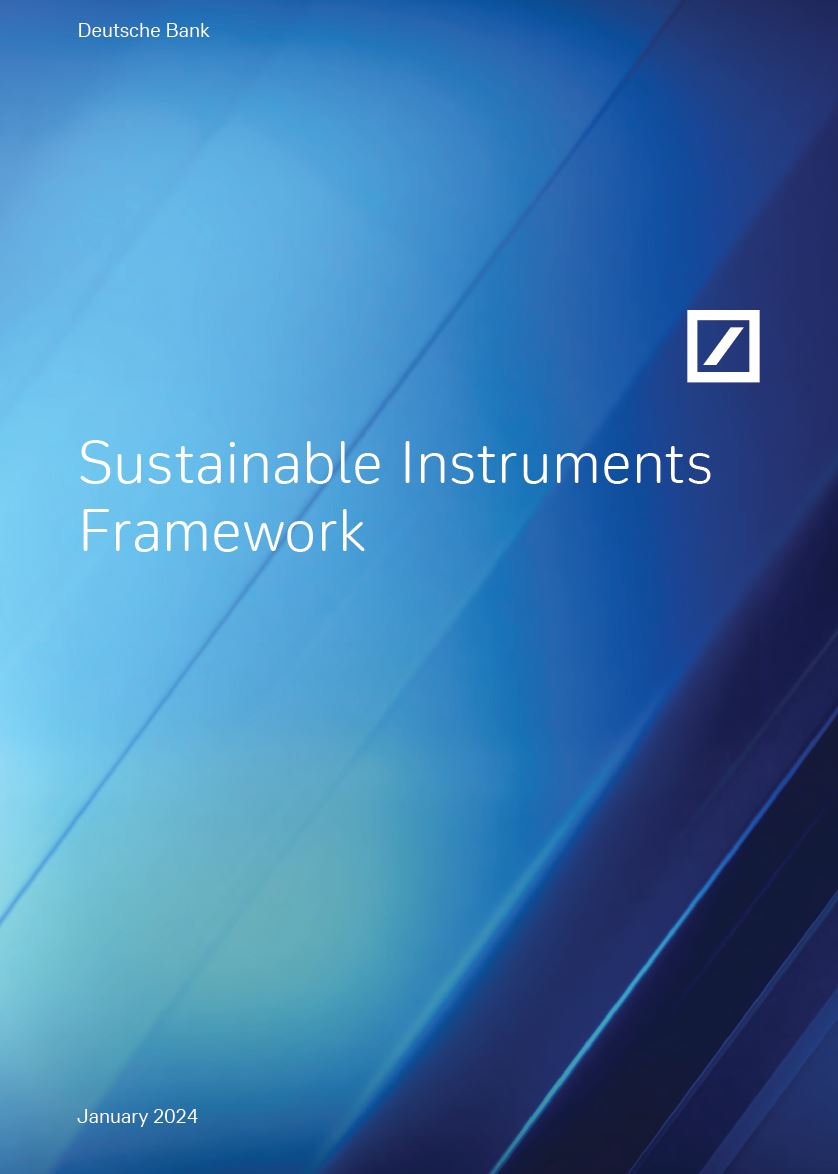As a global financial intermediary, we have a role to play in facilitating the transition of economies towards sustainable and low-carbon growth. We support this transition through our business activities by directing financial flows towards more sustainable and climate-friendly solutions.
200
bn EUR
2022 target outperformed (215 bn EUR at YE 2022)
500
bn EUR
Target cumulated until 2025
+21
bn EUR
in Q4 2024
373
bn EUR
cumulative since Jan. 2020 by Q4 2024
Download PDF Initial Transition Plan
Deutsche Bank’s initial Transition Plan consolidates the bank’s definitions, methodologies, targets and achievements on its path to net-zero by 2050.
Sustainable finance frameworks
The bank’s sustainability-related framework landscape follows generally accepted international standards and principles, including the International Capital Market Association Green and Social Bond Principles, UN Global Compact, and EU Taxonomy. It aims to prevent harmful business activities and identify sustainable finance opportunities.
Show content of Sustainable Finance Framework
|
The Sustainable Finance Framework, introduced in 2020 and updated in 2024, defines the methodology and procedures for classifying transactions and financial products and services as sustainable. It is, where feasible, aligned to the EU taxonomy. The independent consultancy ISS ESG confirmed in a second party opinion that Deutsche Bank’s Framework is consistent with “market practices” and that its content is aligned with the bank’s existing sustainability criteria. |
 |
Show content of ESG Investments Framework
|
In 2024, DB also published the ESG Investments Framework which sets out criteria and evaluation processes to report investments as ESG in the context of Deutsche Bank Group’s sustainable finance and ESG investment targets. The ESG Investments Framework complements the bank’s Sustainable Finance Framework. The purpose of the Framework, which may be updated from time to time, is to have a single, consistent methodology in place for the classification of financial instruments and managed portfolios to be reported as Assets under Management (AuM) under the bank’s Targets. |
 |
Show content of Sustainable Instruments Framework and reporting
|
Sustainable Instruments Framework The purpose of the Sustainable Instruments Framework, which may be updated from time to time, is to have a single, robust methodology in place for the issuance of “use of proceeds”-based sustainable financing instruments, including Green Financing Instruments and Social Financing Instruments. It covers all Sustainable Financing Instruments that can be issued in the form of (covered) bonds, commercial papers (CPs), repurchase agreements (Repos), and deposits. The Framework is an expansion of DB’s Green Financing Framework to include two Social asset categories, Affordable Housing and Essential Services (health & social care), in addition to the existing green categories, Green Buildings, Renewable Energy, Energy Efficiency, Clean Transportation and Information and Communications Technology. The independent consulting firm Institutional Shareholder Services ESG (ISS ESG) has reviewed the bank’s Sustainable Instruments Framework and results are documented in a Second Party Opinion (SPO), which confirms that the Framework meets the ICMA Green and Social Bond Principles at the time of its publication. Reporting In alignment with the voluntary ICMA Green Bond Principles and Social Bond Principles, the bank is committed to publish relevant information and documents regarding our Sustainable Financing Instruments in a dedicated Sustainable Financing Instruments Report, which will be made available on our Investor Relations website on an annual basis. The report is split into two parts – the allocation reporting and the impact reporting. The most recent Green Financing Instruments Report (based on the previous Green Financing Framework) has received a limited assurance from ISS-ESG, which confirms that the allocation and impact reporting are aligned with the ICMA Harmonised Framework for Impact Reporting. |
|
Show content of Summary Framework on Environmental and Social Due Diligence
|
The Summary Framework on Environmental and Social Due Diligence defines rules and responsibilities for risk identification, assessment, and decision-making, and specifies the requirements for environmental and social due diligence. |
 |
Show content of Disclaimer
The transition to a sustainable economy is a long-term undertaking. In its current stage, we are confronted with the limited availability of climate related data. Use of estimates and models is inevitable until improved data becomes available. Our expectations for increasing data quality are based on reporting obligations as currently developed. New regulations on reporting will likely become effective in the coming years. Harmonized standards and calculation methods are expected to be developed and will also improve data quality.
The sustainability targets on this website includes metrics that are subject to measurement uncertainties resulting from limitations inherent in the underlying data and methods used for determining such metrics. The selection of different, but acceptable measurement techniques can result in materially different measurements. The precision of different measurement techniques may also vary. The information set forth herein is expressed as of end of October 2023, and we reserve the right to update its measurement techniques and methodologies in the future.
We have measured the carbon footprint of our corporate loan portfolio in accordance with the standards we discuss in our report on corporate loan portfolio financed emissions and net-zero-aligned pathways for focus sectors (Towards net-zero emissions). Furthermore, we have measured the carbon footprint of our European Real Estate loan portfolio in accordance with the standards we discuss in our report on Residential Real Estate – Leading to Net-zero. In doing so, we partly used information from third-party sources that we believe to be reliable, but which has not been independently verified by us, and we do not represent that the information is accurate or complete. The inclusion of information contained in on this website should not be construed as a characterization regarding the materiality or financial impact of that information.
If emissions have not been publicly disclosed, these emissions may be estimated according to the Partnership for Carbon Accounting Financials (PCAF) standards. For borrowers whose emissions have not been publicly disclosed, we estimate their emissions according to the PCAF emission factor database. Since there is no unified source of carbon emission factors (including sustainability-related database companies, consulting companies, international organizations, and local government agencies), the results of estimations may be inconsistent and uncertain.
Past performance and simulations of past performance are not a reliable indicator and therefore do not predict future results.
This website contains forward-looking statements. Forward-looking statements are statements that are not historical facts; they include statements about our beliefs and expectations and the assumptions underlying them. These statements are based on plans, estimates, and projections as they are currently available to the management of Deutsche Bank Aktiengesellschaft. Forward-looking statements therefore speak only as of the date they are made, and we undertake no obligation to publicly update any of them in consideration of new information or future events. By their very nature, forward-looking statements involve risks and uncertainties. Several important factors could therefore cause actual results to differ materially from those contained in any forward-looking statement. Such factors include the conditions on the financial markets in Germany, in Europe, in the United States, and elsewhere, from which we derive a substantial portion of our revenues and in which we hold a substantial portion of our assets; the development of asset prices and market volatility; potential defaults of borrowers or trading counterparties; the implementation of our strategic initiatives; the reliability of our risk management policies, procedures and methods; and other risks referenced in our filings with the U.S. Securities and Exchange Commission. Such factors are described in detail in our most recent SEC Form 20-F under the heading “Risk Factors.” Copies of this document are readily available upon request or can be downloaded from our website.

